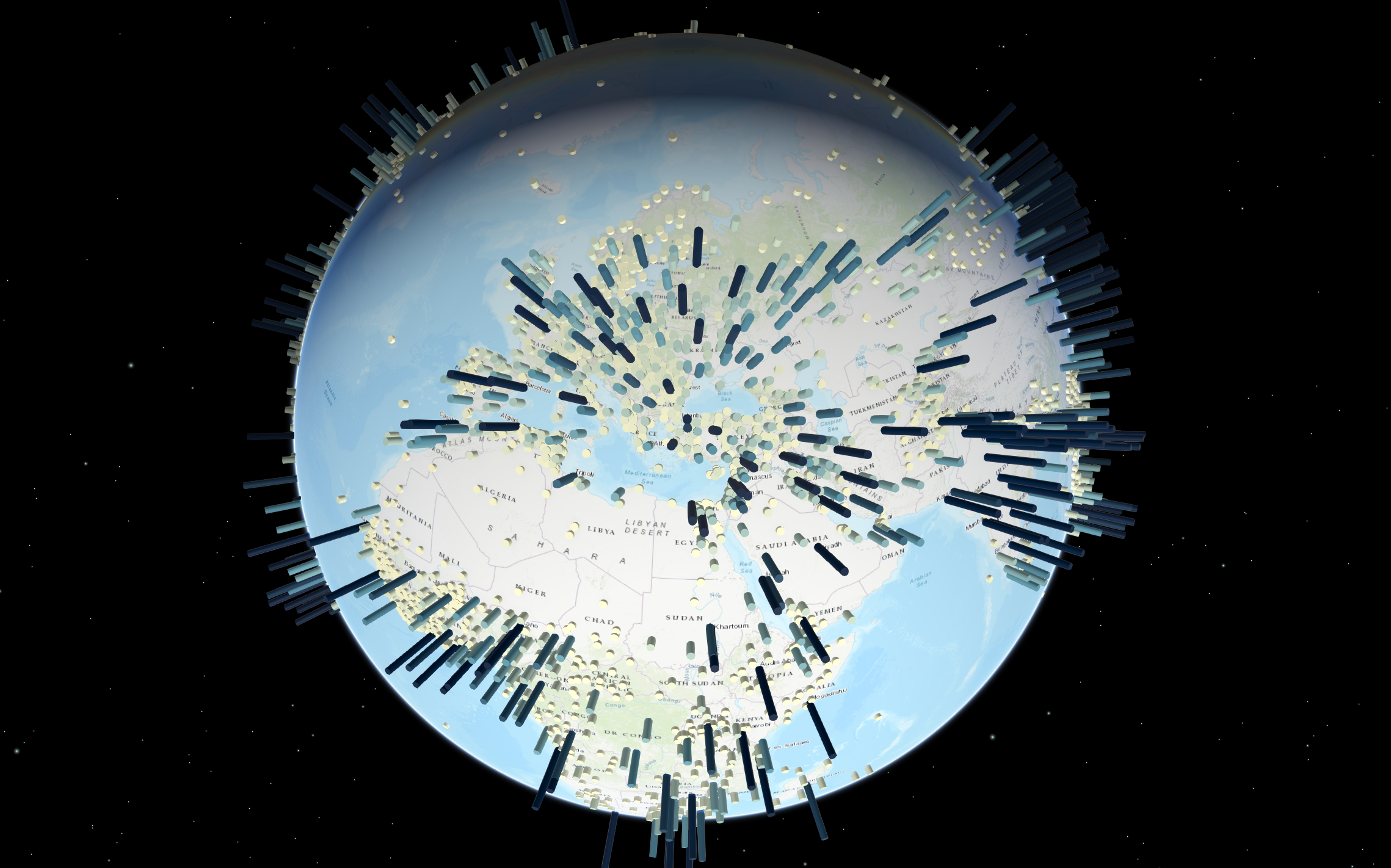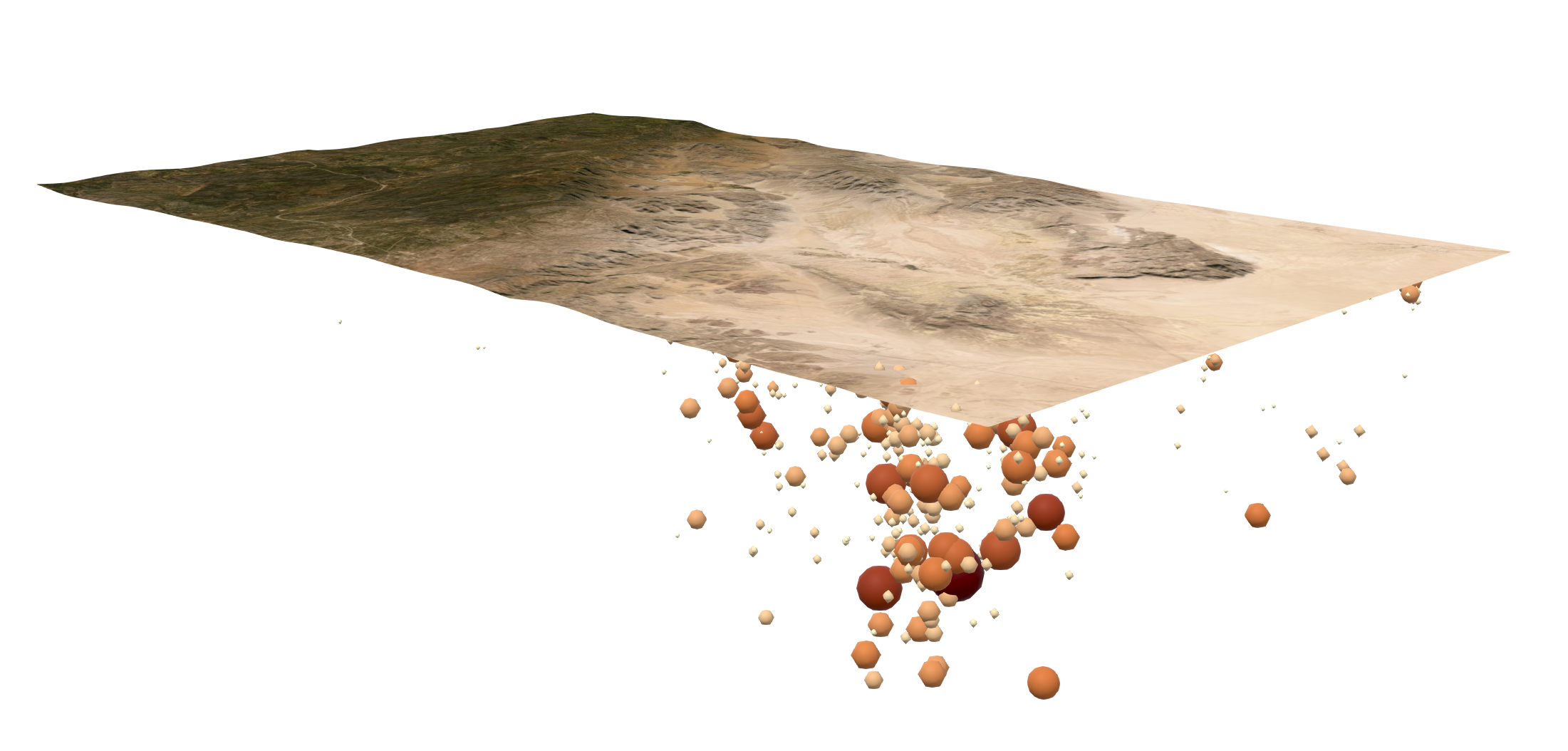A scene allows you to visualize data and analyze geographic information in an intuitive and interactive 3D environment. You can use a global or local scene to best display your data, such as airline flight patterns, campus facilities, or underground utilities. You can view scenes in either Scene Viewer or ArcGIS Pro.
Global scene
In a global scene, you can display spatial content on a sphere based on world coordinate systems. A global scene is good choice use when you want to understand or provide context for phenomena that wrap around the spherical surface of the earth, such as global weather measurements, world population, or shipping lanes. You can also use a global scene to display data at a city level or down to a building site level. See an .

Local scene
The main differences between local scenes and global scenes are that local scenes can display data that has a spatial reference in a local projected coordinate system, and the terrain and layers are shown projected on a planar surface rather than on a sphere. Local scenes are best used for displaying or analyzing data at the local or city scale that have a fixed extent in which you work. Local scenes are helpful for urban planning and visualization such as when viewing campus facilities or building developments. You can clip the extent of a scene and navigate underground and interact with subsurface data, such as utility networks or earthquake data. See an .

Tip:
Clipping the extent of a scene increases performance and allows for easier navigation underground.
Local cached data can have tiling schemes different than in global scenes and can be added to one local scene without the need for reprojection. For example, you have an urban planning project and want to show buildings in your town, streets, parks, and rivers, and the proposed elements of the project. You may be working with data designed by engineers and planners that is projected in a local projected coordinate system. You can add this urban project data to a local scene and share it with your organization, stakeholders, and the public.
If the data extent spans a large geographical area, it is recommended that you use a global scene.
Create a global or local scene
When you are signed in to your account, you can create a new global or local scene or open a previous one.
To create a scene, complete the following steps:
- Click New Scene
 at the top of Scene Viewer.
at the top of Scene Viewer. - From the list, click New Global Scene, New Local Scene, or open an existing scene.
A new or existing scene opens: a global scene has the Global Scene icon
 ; a local scene has the Local Scene icon
; a local scene has the Local Scene icon  .
. Tip:
Hover over the scene icon to see the scene spatial reference.
When you first open a new scene, you can switch the basemap multiple times to any of the active basemaps before you set the spatial reference for the scene.
When you are signed in to your account and you open Scene Viewer, the default basemap set by your organization determines whether a global or local scene opens.
Layer support for global and local scenes
There are differences in layer support between global and local scenes.
Global scene
Global scenes support the following layer types:
- Tile layers in Web Mercator (Auxiliary Sphere) or supported GCS: WGS84 or CGCS 2000
- Scene layers in Web Mercator (Auxiliary Sphere) or supported GCS: WGS84 or CGCS 2000
- Noncached layers with any spatial reference
Local scene
Local scenes support the following layer types:
- Tile layers in any projected coordinate system, WGS84, or custom coordinate system defined by a well-known text (WKT) string
- Scene layers in any projected coordinate system, WGS84, or custom coordinate system defined by a WKT string
- Noncached layers with any spatial reference
Note:
- Cached layers and basemaps in a scene must have the same spatial reference.*
- Noncached layers with different spatial references can be added to scenes, since the services are reprojected to match the spatial reference of the scene.
* You can add a WGS84 scene layer to a scene in Web Mercator (Auxiliary Sphere).
Global and local scene considerations
The following sections describe some things to keep in mind when you're working with scenes.
Cached layers
Cached layers (elevation layers, imagery layers, scene layers, tile layers, and vector tile layers) are prerendered collections of map cartography or 3D objects organized by location and scale. Cached layers support fast visualization of complex maps, since the server distributes the preprocessed and compressed data whenever someone requests a map.. With cached layers, the spatial reference is defined in the service, so it is not possible for them to be reprojected on the fly.
Noncached layers
Noncached layers (feature layers and dynamic map image layers) are a collection of geographic features. Each feature in the collection has a location, a set of properties, attributes, map symbology, and a pop-up. With a noncached layer, the spatial reference is not defined in the cache and there is no tiling scheme. A noncached layer can be reprojected on the fly to match the basemap, and you can always display noncached layers in a global or local scene.
Tiling scheme
Tile, map image, imagery, and elevation image layers are cached layers and are based on a tiling scheme. Scene layers are cached layers but aren't based on a tiling scheme. In global scenes, you can add cached layers that have either the ArcGIS Online/Bing Maps/Google Maps tiling scheme or WGS1984 Geographic Coordinate System, Version 2 tiling scheme. In local scenes, you can add layers that use a custom tiling scheme as well. All tiling schemes must meet the following Scene Viewer requirements:
- Size: 256 by 256 or 512 by 512 pixel tiles.
- The scale levels must increase or decrease by a power of two.
For example, if the scale starts at 1:128,000, the next levels are 1:64,000 and 1:32,000.
Basemap
When you open a new scene, the default basemap plays an important role whether it's a global scene or a local scene. If the default basemap is in Web Mercator or WGS84, a new global scene opens. If the default basemap is in a projection other than Web Mercator or WGS84, a local scene opens. Depending on your privileges, you can use your own basemaps to create a custom basemap gallery. Basemaps must have a valid tiling scheme to be added to Scene Viewer.
In global scenes, basemaps that are not in Web Mercator or WGS84 will be disabled in the gallery. Also, if the default basemap is not in Web Mercator or WGS84, when you open a new global scene, the basemap will be dropped. To work with these disabled basemaps, open a new local scene. The configured maps appear in the gallery.
Set the spatial reference of a scene
You set the scene spatial reference when you add a layer, capture a slide, or save the scene. At that time, the scene tiling scheme is also set. Once the spatial reference of the scene is set, keep the following in mind:
- You can only add cached layers that match the scene spatial reference and tiling scheme.
- All basemaps that don’t match the scene spatial reference and tiling scheme are disabled.
The following are additional considerations:
- The spatial reference of the scene is always set to the first layer's spatial reference.
- The tiling scheme of the scene is always set to the first layer's tiling scheme.
- If the first layer is a noncached layer, the spatial reference and tiling scheme use the basemap's settings.
- When you create a slide or save a scene without adding a layer, the spatial reference and tiling scheme use the basemap's settings.
- If the first layer that's added doesn't match the spatial reference of the basemap, you can add the layer to the scene and drop the basemap.
Open a layer in Scene Viewer from ArcGIS Enterprise
Keep the following in mind when opening a layer in Scene Viewer:
- If you open a Web Mercator or WGS84 layer, a global scene opens.
- If you open a projected coordinate system layer, a local scene opens.